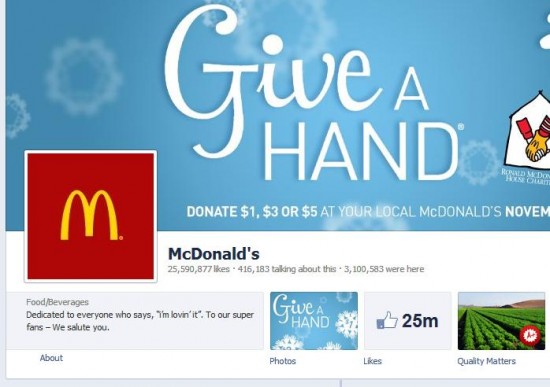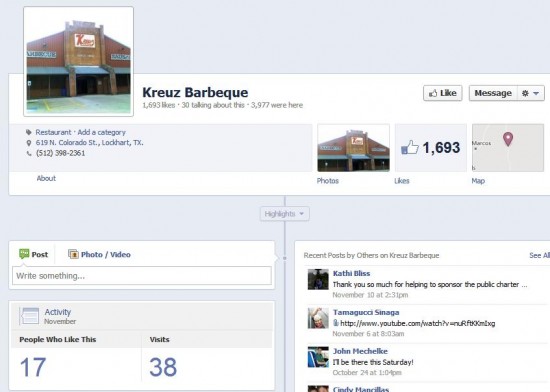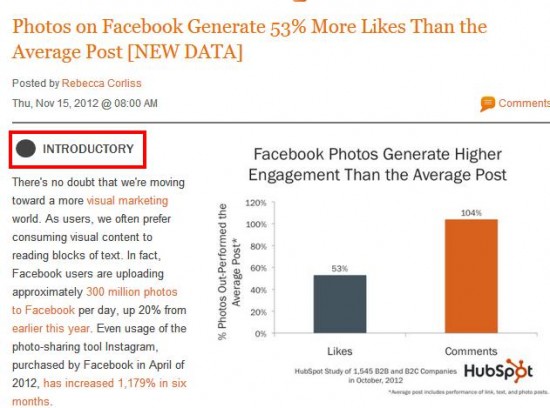 There are thousands of inbound marketing blogs on the Internet today. Some are targeted to marketing professionals on Fifth Avenue, and some are written for bloggers trying to make some extra income from home.
There are thousands of inbound marketing blogs on the Internet today. Some are targeted to marketing professionals on Fifth Avenue, and some are written for bloggers trying to make some extra income from home.
Bloggers go into detail about how to get more Facebook fans, how to respond to blog comments, how to optimize your posts for search, and numerous other topics. The majority of those topics can be applicable to all types of digital marketing practicioners, but every level of marketing calls for a different approach to both strategy and technique.
Is This Approach for You?
The biggest problem I have with the format most digital marketing blogs take is that they don’t adequately identify their target audience. Social Media Sun is often guilty of this same problem as well. In some cases it is assumed; Glenn Allsop is writing for average bloggers trying to reach a wider audience using web tactics. Social Media Explorer on the other hand is more geared toward the strategy that marketing professionals working for large firms would use for big brands. The differences are sometimes subtle, but important nonetheless.
To better understand my point, consider two separate brands on Facebook. Brand 1 is the International burger chain McDonalds. Brand 2 is the local barbeque pit McDaniels. Let’s examine the differences in approach each brand would take from the perspective of the person that handles the digital marketing.
Enterprise Account Manager
McDonalds: Having started out with millions of fans inherited from Facebook’s initial likes feature, attracting new fans wasn’t a huge priority at first. The fact that everyone in the country is familiar with the brand raises the stakes considerably. We would first need a stringent social media policy and training for all the employees that were given access to the page.
Since we have restaurants open all across the globe, we would need additional support for International marketing. Each country will have its own special page. Since we can attract more likes than we’ll ever need simply by putting a Facebook logo on our fry boxes, our main priority will be generating positive engagement from the fans we already have. This will help keep a positive tone present on our page since our brand will most definitely attract trolls, and will also help us identify the things we’ve done to make these fans evangelists.
Besides engagement, we will invest heavily in analytics and research. Every post that takes 10 minutes to craft will have over an hour of research and optimization. When a 5 percent increase in impressions means we’ll reach 1,250,000 more fans, optimization is the biggest return on investment we can generate. Since our brand is a global icon and currently a target of activists for nutrition, a target of paranoid conspiracy theorists for preservatives, and a target of advocacy groups because we market to children, we’ll focus on posts that are hard to demonize. Our Ronald McDonald house charity and other children’s charities are powerful partners.

McDonalds can rely on their worldwide popularity to bring in new fans. Focus changes from attracting fans to catering to the fans you have.
Our posts would adhere to themes, and enforce integrated marketing campaigns that we’re running across several media channels. Right now the focus is on value and freshness/quality. McDonalds has a new application that takes you to the farms and suppliers that are the source of all their product. It’s surprising to see real potatoes and clean cattle associated with McDonalds. Remind Kids that just left school that the McDouble is still only 1$. They don’t have to go hungry even though they’re broke, and they’re almost definitely checking their Facebook accounts because we have a measurable spike in those demographics between 2:45pm EST and 4pm EST. Our enterprise analytics software collects all the data that we could possibly measure and we use every bit of it to reach as many fans as possible.
Even though we’re a multinational brand, locally owned stores and a rare ubiquity are some of our most wonderful assets. That’s why we’ve worked hard to integrate an application that drills content down to the local level, allowing each store to have some control over their branding; after all, the customers in Bangor Maine don’t have the same tastes as the customers in El Paso. Since Facebook is unpredictable we capture e-mails for coupon clippers and brand advocates so they’ll get our most important messages regardless of how fickle Facebook is. We also integrated customer cupport into our Facebook page so the professionals handling our content aren’t hindered with complaints and the employees with special training are addressing customers.
Small Business Owner
McDaniels: Attracting a following of 2,000 fans was fairly hard work. Luckily our establishment has been a hometown favorite when Mark Zuckerberg was still on the tit so our customers were quick to like our page, and they have been checking in long before we got our Foursquare account integrated.
Even with 2,000 fans, our average posts are just reaching 400 fans. We invested some money in a high quality DSLR Nikon, and send out pictures of our specials everyday (we pose the food for the camera!) through Instagram, which is directly connected to all our other channels through IFTTT.
Since we are only a small brand and do not have the means to hire a full time marketing professional, we automate content distribution as long as it doesn’t cause a problem. One Monday afternoon each month the employees come in an hour early and we have a brand management meeting where we go over the last month, instruct them on their participation in our social media campaigns, promote some of the staff to contributors, give others initial instruction on how they should portray themselves and our brand on social media, and lay out our strategy and goals for the month ahead.

One of the most important aspects of Digital Marketing for small businesses is making sure that everything is set up correctly so actions and reviews are correctly attributed to your establishment. Make sure your business is also designated as a location so when customers check in an update will go out to their friends.
We have been updating our community blog weekly for over a year. Different citizens, and even a few journalists from the local paper, have contributed content free of charge. People often tell us that we’re a better source of community news and events than the local newscast. We cover the high school football team, parades and festivals, tourism, and barbeque. Some of our posts are even ranking for barbeque related terms in search engines. We were even featured on a nationally syndicated food show after their crew researched our area on the Internet.
Three days every week I go through a list of review websites including Yelp!, Google Local, and others. Most days there are only one or two new comments and it never takes more than 20 minutes. I thank everyone that left a positive comment and personally respond to every negative comment. We take all criticism seriously and complaints are thoroughly investigated, When I can I offer the patron a discount for their next visit and try to make their negative experience right. These people have become some of our most die hard fans. They can’t believe that I even contacted them, let alone addressed the problems and offered them a free meal.
We promote area hotels and attractions that have a reputation for quality. We have become associated with the best hotels and attractions this way, and they often recommend McDaniels to their guests. It’s a positive feedback loop. Since we’ve begun to have so much success, I bottled some of mom’s famous sauce last week and started selling it mail order from our website. We sold out in a few hours, and the positive response was overwhelming. We included a link to our Facebook page, Twitter handle and Pinterest account on the jar. It brought us a dozen fans from all over the country after one of the people who purchased a jar used it at a block party.
I do spend some time analyzing Facebook data, but for the most part the difference between reaching 400 and 450 fans is negligible. I don’t spend much on promoted posts unless there is a special event, or I post about the new sauce we’re selling through our website. We spent some hours integrating the new Schema markup into our website and Google+ profile. Very few local establishments have done this. We’ve built a considerable lead when it comes to 4 star ratings and we’ve had a small increase in business because our Google profile shows up at the top of local search.
The Real Difference
With such vast differences in infrastructure, resources, audience size, available software and policy it’s almost like digital marketing for large brands is a whole different subject than small business. If you’re an experienced marketer you can tell which articles are written for small business and which articles are written for account managers at Oglivy.
My problem (and the problem a lot of other blogs encounter) is that I have consulted for people who are on both sides of the fence and I have a lot of readers that are exposed to both worlds
The Solution
The most obvious solution would be to pick an audience (small business owners or agency employees) and stick to it. In fact, I would recommend that approach to anyone wanting to start a new digital marketing blog. You should already know who your audience is. If you’re a service business, you probably target enterprise accounts or small businesses anyway.
- You could tag each post according to the intended audience.
- For the most part, Google Algorithms and Facebook Edgerank are supposed to work the same for Wal-Mart as they work for Tom’s Feed and Seed. Write universal articles in a way that is applicable to all uses.
- ou could educate your readers about the different marketing approaches used and the importance of finding your own solutions based on your own situation (which is what I’ve tried to do today).

Hubspot’s blog includes a tag and a visual indicator regarding the experience level involved in each post. It doesn’t identify small business vs agency, but it’s a start.
At Social Media Sun we’re working on several projects that will be valuable to all digital marketing professionals. Some are special for small business owners, and some would be more useful for larger operations. Almost everything we do has some value for both circles.
What do you say? Do you recognize your own needs concerning which blogs you follow? Does the combination of agency topics like “How to Decrease the Response Time on Negative Comments” and small business topics like “How to Make Your Brand’s Logo Stand Out” affect your opinion about a blog? How often do you read posts that aren’t relevant to your business or position?
- Blogging Isn’t a Rocket, It’s More Like a Roller Coaster - August 19, 2025
- Value vs. Expectations: The Fight for Startup Survival - July 31, 2025
- The Evolution of Marketing: From Catalogs to Cat Blogs - November 8, 2022
- How to Make a Tweet This Link - February 5, 2022
- Dramatically Improve Marketing Results with Advanced Analytics - September 20, 2021
- The Next Chapter for Social Media Sun - June 4, 2013
- Optimizing Your FAQ to Maximize ROI - December 5, 2012
- Weapons of Influence and Klout’s Role in Marketing - November 17, 2012

Thanks, Adam – “one size fits all” certainly doesn’t work here!
Thanks for stopping by BBB. I hope I gave everyone some ideas and insight no matter what position they’re in.
Hi Adam,
My first time on your site. Lots of great information. The biggest take away people should get from your post is that you need to identify your target audience and stay congruent to it whilst building your following. Whether that is on Facebook, Twitter or anywhere else.
Thanks for sharing,
Beth Hewitt 🙂
Great observation Beth. Lack of Strategy and inadequate audience identification are the 2 biggest problems most businesses have when they try to integrate digital marketing.
I try to keep all the information on this site as relevant and accurate as possible. When it comes to the Internet, people spread false information about as much as the urban legends on Facebook. I don’t know if they just want everyone else to fail or if it’s just because they’ve heard a specific piece of information so many times.
Relevant and accurate has proven to be the easy part -common sense really goes a long way. Unique has proven to be the hard part lol
I love the layout to this post. It’s easy to read and distinguish the different examples. Thanks for sharing the great information Adam.
As an inbound marketer, creating content or overseeing content generation (graphics, video, blog posts, etc.) is probably one of your main tasks. But, what if you could give your employees and users the chance to create the content for you? For one, it definitely takes a lot off your plate. User generate content plays a key role in every step of inbound marketing cycle, from attracting customers in the awareness stage to converting to closing leads and delighting promoters.